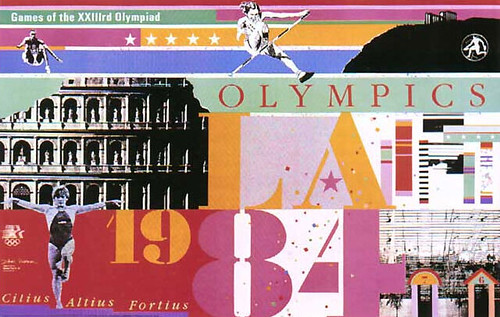"Term used from about 1970 to describe changes seen to take place in Western society and culture from the 1960s on. These changes arose from anti-authoritarian challenges to the prevailing orthodoxies across the board. In art, postmodernism was specifically a reaction against modernism. It may be said to begin with Pop art and to embrace much of what followed including Conceptual art, Neo-Expressionism, Feminist art, and the Young British Artists of the 1990s. Some outstanding characteristics of postmodernism are that it collapses the distinction between high culture and mass or popular culture; that it tends to efface the boundary between art and everyday life; and that it refuses to recognise the authority of any single style or definition of what art should be."
Sussman, D (1984), Olympic poster design
http://farm6.static.flickr.com/5251/5456129686_1280623b58.jpg
This poster has taken an intuitive collage approach, an odd colour scheme with a random mix of textures which make it a classic postmodern design.

Nagai, K (198?), Japanese poster Design
http://images.artnet.com/WebServices/picture.aspx?date=20020506&catalog=15460&gallery=111588&lot=00115&filetype=2
Again the use of bold colours, moving away from the crisp and simple ideologies of modernist graphic design. Also the overlapping shapes take a playful and decorative approach, a complete opposite of 'form follows function'
Weingart, W (1982), exhibition poster
http://www.oberholtzer-creative.com/visualculture/wp-content/uploads/2008/08/weingart.jpg
The expressive shapes and typography, also a recurring element within postmodernist posters is type in bars. Other elements in the image are the range of textures and again odd colour scheme. The layers of faded patches colour and cut off elements of type move away from the formed crisp layouts of modernist design.
http://www.uartsgd.com/Archive/ArchiveAllemann/pages/1991_Hiebert_HA.html
This deconstructionist approach is a perfect example of what postmodernism introduced to design. The approach postmodern designers were taking was far more aesthetic based, a form could be placed in a space because it 'feels right' rather than for-filling a rational communicative need.
Greiman, A (1979) Wet Magazine cover
http://www.britannica.com/EBchecked/topic-art/356421/67511/Cover-for-WET-magazine-designed-by-April-Greiman-1979
This poster shows how postmodernism design became eccentric, the designer becoming an artist performing before an audience, the audience either responds or passes on. These intuitive and playful aspects of postmodern design could be to reflect personal involvement with the spirit of the decade.



